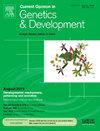转座子在生殖细胞中的持久性和控制
IF 3.6
2区 生物学
Q2 CELL BIOLOGY
引用次数: 0
摘要
转座子,或“跳跃基因”,是普遍存在的基因组元素,具有驱动进化创新和通过基因突变和DNA损伤破坏基因组完整性的双重能力。它们的活性在生殖细胞中尤为显著,生殖细胞将遗传物质传递给下一代。这些细胞中的转座子活性体现了一种微妙的平衡:有限的转座子活性可以引入遗传多样性并推动进化,而不受控制的转座子活性可能会导致DNA损伤、不育和适应性丧失。作为“自私基因”,转座子进化出了一些策略,以确保它们的繁殖不会危及宿主的生存。这种复杂的关系提出了一个令人信服的问题,即转座子的活性是如何被调节以维持基因组的稳定性和进化潜力的。在这篇综述中,我们探讨了生殖细胞中抑制转座子的小RNA通路,即piwi相互作用RNA通路的最新进展。此外,我们强调转座子如何创造性地绕过抑制。这些发现阐明了宿主和转座子之间的动态相互作用,为基因组进化和保存提供了更深入的见解。本文章由计算机程序翻译,如有差异,请以英文原文为准。
Transposon persistence and control in germ cells
Transposons, or ‘jumping genes’, are ubiquitous genomic elements with the dual capacity to drive evolutionary innovation and disrupt genome integrity through gene mutation and DNA damage. Their activity is particularly significant in germline cells, which transmit genetic material to the next generation. Transposon activity in these cells embodies a delicate balance: while limited transposon activity can introduce genetic diversity and drive evolution, unchecked mobilization risks DNA damage, sterility, and loss of fitness. As ‘selfish genes’, transposons have evolved strategies to ensure their propagation without jeopardizing host survival. This intricate relationship raises compelling questions about how transposon activity is regulated to sustain both genome stability and evolutionary potential. In this review, we explore recent advances in understanding the small RNA pathway that represses transposons in germ cells, the Piwi-interacting RNA pathway. Furthermore, we highlight how transposons creatively bypass repression. These findings illuminate the dynamic interplay between hosts and transposons, offering deeper insights into genome evolution and preservation.
求助全文
通过发布文献求助,成功后即可免费获取论文全文。
去求助
来源期刊
CiteScore
7.90
自引率
0.00%
发文量
102
审稿时长
1 months
期刊介绍:
Current Opinion in Genetics and Development aims to stimulate scientifically grounded, interdisciplinary, multi-scale debate and exchange of ideas. It contains polished, concise and timely reviews and opinions, with particular emphasis on those articles published in the past two years. In addition to describing recent trends, the authors are encouraged to give their subjective opinion of the topics discussed.
In Current Opinion in Genetics and Development we help the reader by providing in a systematic manner:
1. The views of experts on current advances in their field in a clear and readable form.
2. Evaluations of the most interesting papers, annotated by experts, from the great wealth of original publications.[...]
The subject of Genetics and Development is divided into six themed sections, each of which is reviewed once a year:
• Cancer Genomics
• Genome Architecture and Expression
• Molecular and genetic basis of disease
• Developmental mechanisms, patterning and evolution
• Cell reprogramming, regeneration and repair
• Genetics of Human Origin / Evolutionary genetics (alternate years)

 求助内容:
求助内容: 应助结果提醒方式:
应助结果提醒方式:


